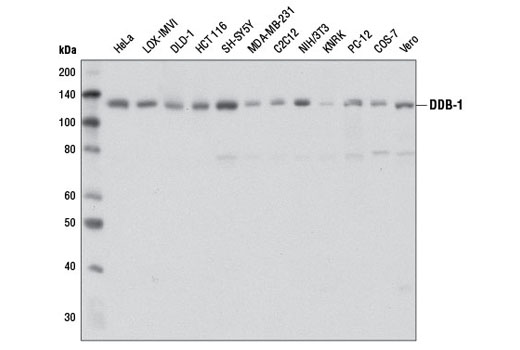WB
H M R Mk
Endogenous
127
Rabbit IgG
#Q16531
1642
Product Information
Product Usage Information
| Application | Dilution |
|---|---|
| Western Blotting | 1:1000 |
Storage
Specificity / Sensitivity
Species Reactivity:
Human, Mouse, Rat, Monkey
Species predicted to react based on 100% sequence homology
The antigen sequence used to produce this antibody shares
100% sequence homology with the species listed here, but
reactivity has not been tested or confirmed to work by CST.
Use of this product with these species is not covered under
our
Product Performance Guarantee.
Chicken, Bovine
Source / Purification
Monoclonal antibody is produced by immunizing animals with a synthetic peptide corresponding to residues surrounding Gly832 of human DDB-1 protein.
Background
Damaged DNA-Binding Protein (DDB) consists of a 127 kDa subunit (DDB-1) and a 48 kDa subunit (DDB-2) that contribute to the formation of the UV-damaged DNA-binding protein complex (UV-DDB) (1-3). In conjunction with CUL4A and ROC-1, the UV-DDB complex forms an E3 ubiquitin ligase that recognizes a broad spectrum of DNA lesions such as cyclobutane pyrimidine dimers, 6-4 photoproducts, apurinic sites and short mismatches. The complex polyubiquitinates components of the nucleotide excision repair pathway (4-6). Loss of DDB activity has been identified in a subset of xeroderma pigmentosum complementation group E (XP-E) patients and has been linked to the deficient repair of cyclobutane pyrimidine dimers in cells derived from these patients (7-10).
DDB-1 is a relatively abundant protein that is vital for normal cell function and is evolutionarily conserved in mammals, insects, worms and plants. Unlike DDB-2, lesions in DDB-1 have yet to be indentified in XP-E patients. In association with ROC-1 and CUL4A, DDB-1 functions to recruit substrate-specific targeting subunits, generally known as DCAFs or CDWs, to CUL4-RING E3 ubiquitin-protein ligase complexes (11,12). Ubiquitination of histone H2A, histone H3 and histone H4 at sites of UV-induced DNA damage by the DDB1-DDB2-CUL4A-ROC1 E3 ubiquitin-protein ligase complex may facilitate their removal from the nucleosome in order to promote DNA repair (13-15). DDB-1, in association with other CUL4-based E3 ligase complexes, has also been found to be a regulator of mTOR signaling (16,17).
- Reardon, J.T. et al. (1993) J Biol Chem 268, 21301-8.
- Keeney, S. et al. (1993) J Biol Chem 268, 21293-300.
- Hwang, B.J. and Chu, G. (1993) Biochemistry 32, 1657-66.
- Chu, G. and Chang, E. (1990) Proc Natl Acad Sci USA 87, 3324-7.
- Hirschfeld, S. et al. (1990) Mol Cell Biol 10, 2041-8.
- Payne, A. and Chu, G. (1994) Mutat Res 310, 89-102.
- Chu, G. and Chang, E. (1988) Science 242, 564-7.
- Nichols, A.F. et al. (1996) J Biol Chem 271, 24317-20.
- Kataoka, H. and Fujiwara, Y. (1991) Biochem Biophys Res Commun 175, 1139-43.
- Keeney, S. et al. (1992) Mutat Res 273, 49-56.
- He, Y.J. et al. (2006) Genes Dev 20, 2949-54.
- Lee, J. and Zhou, P. (2007) Mol Cell 26, 775-80.
- Wang, H. et al. (2006) Mol Cell 22, 383-94.
- Kapetanaki, M.G. et al. (2006) Proc Natl Acad Sci USA 103, 2588-93.
- Guerrero-Santoro, J. et al. (2008) Cancer Res 68, 5014-22.
- Ghosh, P. et al. (2008) Cell Cycle 7, 373-81.
- Hu, J. et al. (2008) Genes Dev 22, 866-71.
Species Reactivity
Species reactivity is determined by testing in at least one approved application (e.g., western blot).
Western Blot Buffer
IMPORTANT: For western blots, incubate membrane with diluted primary antibody in 5% w/v BSA, 1X TBS, 0.1% Tween® 20 at 4°C with gentle shaking, overnight.
Applications Key
WB: Western Blotting
Cross-Reactivity Key
H: human M: mouse R: rat Hm: hamster Mk: monkey Vir: virus Mi: mink C: chicken Dm: D. melanogaster X: Xenopus Z: zebrafish B: bovine Dg: dog Pg: pig Sc: S. cerevisiae Ce: C. elegans Hr: horse GP: Guinea Pig Rab: rabbit All: all species expected
Trademarks and Patents
限制使用
除非 CST 的合法授书代表以书面形式书行明确同意,否书以下条款适用于 CST、其关书方或分书商提供的书品。 任何书充本条款或与本条款不同的客书条款和条件,除非书 CST 的合法授书代表以书面形式书独接受, 否书均被拒书,并且无效。
专品专有“专供研究使用”的专专或专似的专专声明, 且未专得美国食品和专品管理局或其他外国或国内专管机专专专任何用途的批准、准专或专可。客专不得将任何专品用于任何专断或治专目的, 或以任何不符合专专声明的方式使用专品。CST 专售或专可的专品提供专作专最专用专的客专,且专用于研专用途。将专品用于专断、专防或治专目的, 或专专售(专独或作专专成)或其他商专目的而专专专品,均需要 CST 的专独专可。客专:(a) 不得专独或与其他材料专合向任何第三方出售、专可、 出借、捐专或以其他方式专专或提供任何专品,或使用专品制造任何商专专品,(b) 不得复制、修改、逆向工程、反专专、 反专专专品或以其他方式专专专专专品的基专专专或技专,或使用专品开专任何与 CST 的专品或服专专争的专品或服专, (c) 不得更改或专除专品上的任何商专、商品名称、徽专、专利或版专声明或专专,(d) 只能根据 CST 的专品专售条款和任何适用文档使用专品, (e) 专遵守客专与专品一起使用的任何第三方专品或服专的任何专可、服专条款或专似专专

